Your Time has Finished
Loading...
BMAT 2020-S2
Your Score: %
Average Score of All Users:
You performed better than of students
Section Breakdown
| Your Score | Average of all Users | Percentile | |
|---|---|---|---|
| BMAT 2020 S2 |
BMAT 2020 S2
Your score:
Average score:
You performed better than of students
This section is Section 2 of 3.
Speed as well as accuracy is important in this section. Work quickly, or you might not finish the paper. There are no penalties for incorrect responses, only marks for correct answers, so you should attempt all 27 questions. Each question is worth one mark.
You must complete the answers within the time limit. Calculators are NOT permitted.
Good Luck!
Note – if press “End Exam” you can access full worked solutions for all past paper questions
1- Asexual reproduction always produces genetic variation.
2- Gamete production is the only possible source of genetic variation in sexual reproduction.
3- The environment can cause genetic variation.
4- Mutations can produce genetic variation.
Explanation
The correct answer is F.
Asexual production produces offspring which are genetically identical to the parents and hence each other, so statement 1 is incorrect.
Statement 2 is also false because mutations can also be a cause of genetic variation.
The environment can affect genetic variation by altering gene expression (epigenetic variation), so statement 3 is correct.
As per the explanation for statement 2, statement 4 must hence be true.
Therefore only statements 3 and 4 are correct.
A sample of an element consists of two isotopes. The relative abundance of each isotope is shown in the table.

Explanation
The correct answer is E.
The mass number of an element is the total number of protons and neutrons in the nucleus of an atom of that element. So calculate the mass number of each isotope:
Isotope 1 – 31+38=69
Isotope 1 – 31+40=71.
Now find the relative atomic mass of the element using the mass number and abundance of each isotope:
(69×0.60)+(71×0.40)=69.8.
But we do not even need to perform the above calculation, because by inspection there is more (a higher abundance) of the -69 isotope than the -71 isotope. This means the relative atomic mass must be closer to 69 than 71, so it must be below 70, eliminating answer F. Obviously answers A-C cannot be correct because their values are too far away from the mass numbers of the two isotopes. This leaves D and E, but we know the relative atomic mass cannot be below 69, as this is the lowest mass number of a given isotope in the sample, so E must be the answer.
A supermarket has a large open-topped deep freezer to keep products frozen but still visible to customers.
Explanation
The correct answer is D.
In cold air compared to in warmer air, the particles have less energy and so move less frequently and have a more ordered arrangement in which they are closer together. This means that cold air is denser than warmer air. Therefore there would be a graduation of cold air to warmer air moving from the bottom of the freezer to the top, keeping the products near the bottom frozen despite the warmer air above.

Explanation
The correct answer is A.
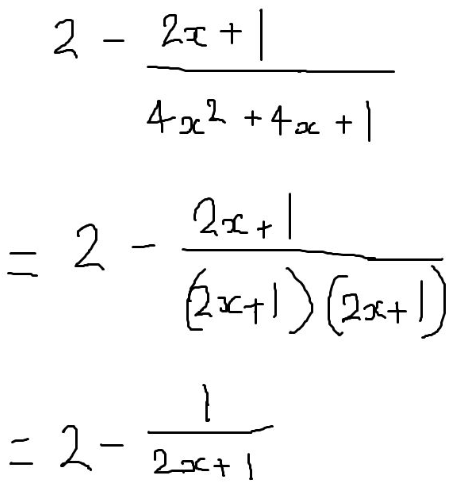
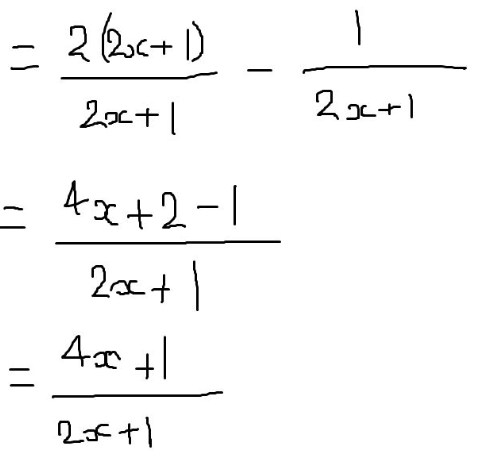
Scientists are using human stem cells to develop treatments for a wide variety of health conditions.
Two types of stem cell that are available for this work are:
• stem cells collected from an early embryo
• bone marrow stem cells collected from an adult
1- Both of these types of stem cell can divide producing daughter cells. Each daughter cell will contain one haploid copy of the donor’s genome.
2- The stem cells collected from an embryo are able to differentiate into a wider variety of specialised cells than the adult bone marrow stem cells.
3- The use of stem cell therapy to treat a medical condition can increase the risk of a person developing cancer.
Explanation
The correct answer is G.
Statement 1 is incorrect because all stem cells divide by mitosis to produce genetically identical diploid daughter cells.
Statement 2 is correct because stem cells taken from early embryos are totipotent (can differentiate into any cell type), whereas adult bone marrow cells are multipotent (can differentiate into a few defined cell types).
Statement 3 is also correct, as if the stem cells continue to divide they can form a tumour.
Therefore only statements 2 and 3 are correct.
 Abid
Medicmind Tutor
Abid
Medicmind Tutor
Mon, 17 Oct 2022 19:57:21
but the questions say to assume no mutations occur. if no mutations are occurring, why is option 3 correct.
Hot, concentrated aqueous sodium hydroxide and chlorine react as shown in the equation:
6NaOH + 3Cl₂ → 5NaCl + NaClO₃ + 3H₂O
1- Chlorine has oxidation state +5 in NaClO₃.
2- This is an example of a disproportionation reaction.
3- Some of the oxygen in the hydroxide ions is oxidised.
Explanation
The correct answer is E.
In NaClO3, the oxidation state of Na is 1+, O is 2-. The overall charge of the compound is 0, so we can work out the oxidation state of Cl:
1+Cl+(-2×3)=0
1+Cl-6=0
Cl-5=0
Cl=5.
Therefore statement 1 is true.
In a disproportionation reaction, the same species is simultaneously oxidised and reduced. The oxidation state of Cl begins as 0 in Cl2, and then changes to 1- in NaCl and 5+ in NaClO3. As the oxidation state of Cl has both decreased and increased, this is a disproportionation reaction so statement 2 is also correct.
The oxidation state of O remains as 2- going from reactants to products, so oxygen has not be oxidised or reduced, so statement 3 is incorrect.
Therefore only statements 1 and 2 are correct.
 VISHNU
Medicmind Tutor
VISHNU
Medicmind Tutor
Fri, 04 Aug 2023 17:43:03
WHERE DID THE O IN NaClO3 COME FROM.IT IS ALSO A HYDROXIDE RIGHT FROM LEFT IN H2O?
An electric fan heater contains a heating element and a motor that drives the fan. The circuit diagram is shown.

At first, the switch is open and the current in the motor is 0.40A.
The switch is then closed.
1- The current in the heating element added to the current in the motor is 0.40A.
2- The voltage across the heating element is 240V.
3- The resistance of the circuit is smaller than it is with the switch open.
Explanation
The correct answer is G.
 anon
Medicmind Tutor
anon
Medicmind Tutor
Mon, 10 Oct 2022 15:06:52
When the switch is closed, the motor remains connected directly to the power supply and so the voltage across it is 240 V, which means that the current in the motor remains 0.40 A. Since there is a voltage across the heating element, there is a current in it. The current in the heating element (which is greater than zero) added to the current in the motor (0.40 A) is greater than 0.40 A, and so statement 1 is not correct. The heating element is connected directly to the power supply and so the voltage across it is 240 V. Statement 2 is correct. Initially, the resistance of the circuit is equal to the resistance of the motor. When the switch is closed the two components constitute a parallel arrangement of resistors. The resistance of the circuit is now equal to the resistance of the parallel combination. The resistance of any parallel combination is less than the resistance of any individual component. It follows that the resistance of this parallel combination (which is the new resistance of the circuit) is less than the resistance of the motor on its own. Hence the resistance of the circuit has decreased and statement 3 is correct.
 Georgina
Medicmind Tutor
Georgina
Medicmind Tutor
Sat, 15 Oct 2022 15:30:20
explanation?
 Georgina
Medicmind Tutor
Georgina
Medicmind Tutor
Sat, 15 Oct 2022 15:30:44
oops didn't scroll down
 Abhi
Medicmind Tutor
Abhi
Medicmind Tutor
Tue, 18 Oct 2022 00:14:08
Explanation please!
In a sale, the normal price of a camera is reduced by 20%.
The sale price of the camera is £180.
Explanation
The correct answer is D.
Normal price x 0.80 = £180
Normal price = £180/0.80.
Some rabbits have a genetic condition. The dominant allele codes for this condition.
A homozygous dominant rabbit mated with a rabbit that did not have the condition.
They had three offspring.
One of the offspring then mated with a rabbit that did not have the condition and they also produced three offspring. Two of the offspring had the condition and one did not.
One body cell that is in early interphase is taken from each of the rabbits in these three generations.
Explanation
The correct answer is B.
Let the dominant allele for this condition be R and the recessive allele be r.
The cross between the homozygous dominant rabbit and rabbit that did not have the condition can be represented as RR x rr.
There is only one possible genotype which can be produced from this cross, which is Rr.
A rabbit with genotype Rr was then mated with a rabbit without the condition: Rr x rr.
Two of the offspring produced from this cross had the condition, so must have had the genotype Rr.
One of the offspring did not have the condition, so must have had the genotype rr.
So the genotypes for rabbits in each generation are as follows:
1st gen= RR, rr
2nd gen= Rr, Rr, Rr
3rd gen= Rr, Rr, rr.
So the total number of copies of the R allele would be 7.
The reaction between hydrogen and nitrogen in the presence of an iron catalyst is known as the Haber process. It is a reversible reaction.
The energy profile for this reaction is shown.
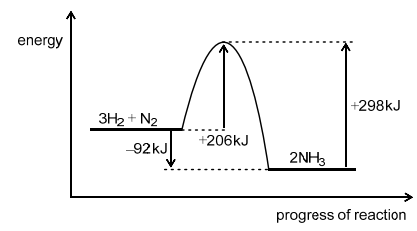
Explanation
The correct answer is A.
Look at the overall energy change going from the reactants to products. This is -92kJ. But we want the reverse reaction, so the enthalpy change would instead be +92kJ. We also only want to decompose 1 mole of NH3, whereas 2 moles are decomposed in the energy diagram, so we must half the enthalpy change +92/2=+46kJ. The ‘+’ sign indicates that the reaction is endothermic, so 46kJ of energy is absorbed when 1 mole of ammonia decomposes.
A ‘gold medal’ used in events such as the Olympic Games is made from a silver–nickel alloy with a coating of a gold–silver alloy.
The mass of the medal is 256 g, of which 24.0g is the mass of the coating.
The density of the silver–nickel alloy is 10.0 g cm–³ and the density of the gold–silver alloy is 16.0 g cm–³.
Explanation
The correct answer is D.
Mass = density x volume, so volume = mass/density.
Mass of the gold-silver coating = 24g.
Mass of the silver-nickel = 256-24=232g.
Volume of the gold-silver coating = 24/16=1.5cm³
Volume if the silver-nickel = 232/10=23.2cm³.
Therefore the total volume of the medal must be 1.5+23.2=24.7cm³.
Triangle PQR is equilateral with sides of length 10 cm.
P, Q, and R are points on the circumference of a circle with centre O.
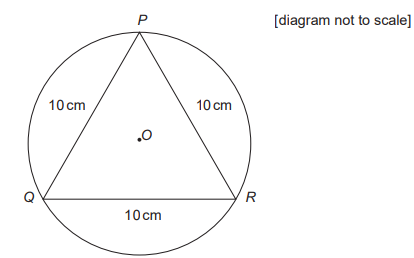
Explanation
The correct answer is D.
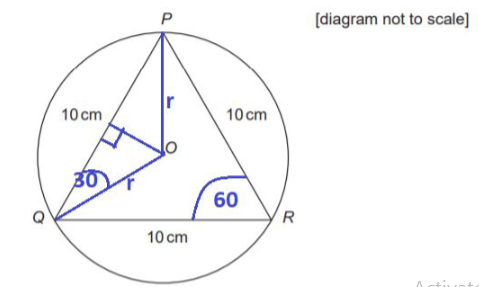
 Alex Dyson
Medicmind Tutor
Alex Dyson
Medicmind Tutor
Mon, 17 Oct 2022 19:07:13
answer should be 5/cos30. given 30 degrees, have 5cm as the adjacent, looking for hypoteneuse so have to use cos, cos(theta)=a/h > cos(30)=5/h > therefore 5/cos(30)=h. and h = r in this case
Several processes can change the proportion of gases in the atmosphere by adding or removing carbon dioxide or oxygen.

Explanation
The correct answer is D.
Looking at the first column in the table, anaerobic respiration in animals does not produce CO2 and photosynthesis removes CO2, so eliminate B and E respectively.
Looking at the second column, aerobic respiration adds CO2 to the atmosphere so eliminate A and F.
Looking at the 3rd column, anaerobic respiration does not produce oxygen, so C is also incorrect.
Therefore D is the correct answer.
Four metals, labelled R, T, X and Z, have the following characteristics:
• R fizzes when added to dilute hydrochloric acid.
• T is precipitated when R reacts with an aqueous solution of a compound of T.
• X is the only one of these metals that occurs naturally on Earth uncombined with other elements.
• Z is the only one of these metals manufactured commercially by electrolysis of one of its molten compounds, whereas R and T can be manufactured by heating their oxides with carbon.
Explanation
The correct answer is F.
T is precipitated when R reacts with an aqueous solution of a compound of T. This means that R is more reactive than T because R is displacing T from the aqueous solution. So eliminate C, E and G, which all place the reactivity of T as greater than that of R.
X is the only one of these metals that occurs naturally on Earth uncombined with other elements. So X is the least reactive of the metals, so eliminate B, D and H.
This leaves A and F.
Z is the only one of these metals manufactured commercially by electrolysis of one of its molten compounds. Therefore Z is the most reactive, so eliminate A.
Hence F is the correct answer.
Thorium-232 ![]() is an unstable nuclide that decays through a sequence of radioactive emissions to form a stable nuclide of lead.
is an unstable nuclide that decays through a sequence of radioactive emissions to form a stable nuclide of lead.
All of the emissions during this sequence are either alpha or beta (β– ) particles.
One of the intermediate nuclides, reached after four alpha and two beta decays, is a nuclide of an element labelled X.
Explanation
The correct answer is C.
For each alpha decay, the mass number decreases by 4 and the proton number decreases by 2. So from four alpha decays, the mass number would decrease by 4×4=16, and the proton number would decrease by 2×4=8.
For each beta decay, the proton number would increase by 1 and the mass number would remain unchanged, so after two beta decays, the proton number would increase by 1×2=2.
So after four alpha and two beta decays, the mass number would decrease by 16 to: 232-16=216, and the proton number would decrease by 8-2=6 to: 90-6=84. So C is the correct answer.
The graphs of the following functions are drawn:
1. y = 2x − 1
2. y = 1 – x²
3. y = (1 – x)²
4. y = 2 − x
Explanation
The correct answer is E.
For the graphs which do intersect, when the equations of the two graphs are made equal to each other they will have solutions, whereas pairs of graphs which do not intersect will not be solvable. So one way of finding which two graphs do not intersect is trying to solve each pair of equations when made equal to each other.
However, this would take a long time, so it a more time- efficient method would be to sketch each graph by finding the x-intercept (when y is made equal to 0) ad the y-intercept (when x is made equal to zero) for each graph. Sketches of the graphs are shown below.
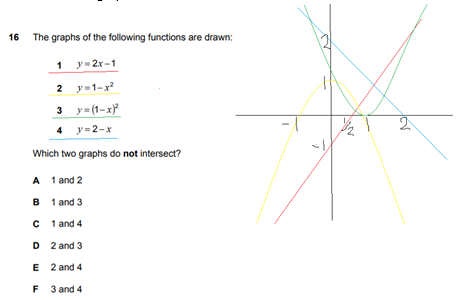
We can see from this sketch that graphs 2 and 4 do not intersect, so E is the correct answer.
Six test tubes were set up. Two different solutions were added to each test tube as shown in the table.
The temperature, pH and all concentrations were optimal.
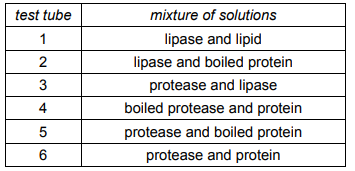
Explanation
The correct answer is F.
Amino acids result from the hydrolysis of polypeptides/proteins. So the mixture must contain some kind of protein (which includes enzymes as they are proteins), so test tube 1 cannot contain amino acids, so eliminate A and B because they both list test tube 1.
Proteins are hydrolysed by proteases or by high temperatures, so as well as protein the test tube must contain protease or the protein must be boiled so that the protein is hydrolysed without protease action. In test tube 4, the protease is boiled, which would denature the enzyme. This would mean it cannot hydrolyse the protein, so this mixture would not contain amino acids. So eliminate C, D, E and G because they all list test tube 4.
Therefore the three test tubes which would contain amino acids would be 3, 5 and 6. So F is the correct answer.
 what a stupid questions
Medicmind Tutor
what a stupid questions
Medicmind Tutor
Fri, 01 Jul 2022 14:50:09
s
Propene is an alkene. The structural formula of propene is shown.

A polymer can be made from propene.
Explanation
The correct answer is D.
The steps which could be taken to determine the structure of the repeating unit of the polymer are shown below.
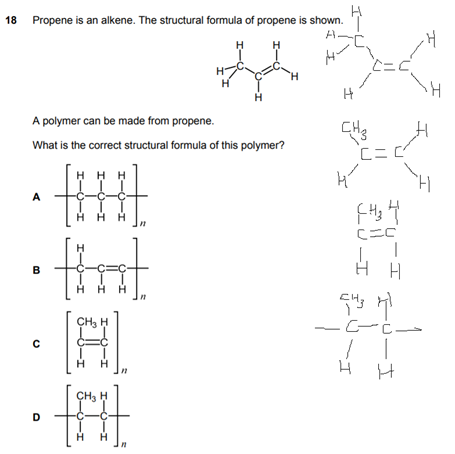
Therefore the answer is D.
A diver of mass 45kg jumps from a diving board and reaches a maximum height of 10 m above the surface of the water in a swimming pool.
Assume Earth’s gravitational field strength is 10Nkg–¹, that air resistance is negligible, and that the diver is treated as a point particle.

Explanation
The correct answer is E.
Gravitational potential energy = mass x gravitational field strength x height
=45 x 10 x 10
=4500J.
Assume that all the gravitational potential energy of the diver is converted into kinetic energy.
Kinetic energy = ½ x m x v²

= √(2 x 100)
= 10√2 m/s.
So the kinetic energy would be 4500J, and the speed 10√2 m/s.
Therefore E is the correct answer.
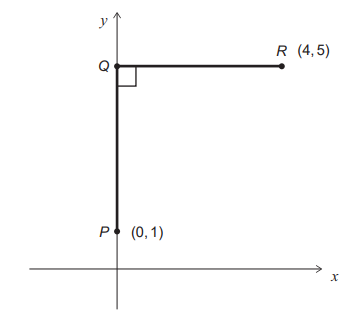
PQRS is a kite. Points P, Q and R are plotted on the diagram.
P is the point (0, 1) and R is the point (4, 5).
angle PQR = 90°
The point Q lies on the y-axis.
The line PS is a segment of the line 2y + x = 2
The coordinates of S are (l,m).
Explanation
The correct answer is F.
The coordinates of the midpoint of the line PR is:
((0+4)/2, (5+1)/2))
=(4/2, 6/2)
=(2, 3).
The line which passes through point Q and S must also pass through the midpoint of the line PR. Therefore we can work out the equation of this line using the coordinated of the midpoint of PR and of point Q. Point Q has the same y-coordinate as R and the same x-coordinate as P, so Q has coordinates (0, 5). The gradient of the line QS must be (3-5)/(2-0)=-2/2=-1, so y=-x+c. Substituting in the coordinates of P:
5=(-1 x 0)+c
5=c.
So the equation of the line QS is y=-x+5.
At point S, the lines y=-x+5 and 2y+x=2 intersect, so we can find the coordinates of S by substituting y=-2x+5 into 2y+x=2:
2(-x+5)+x=2
-2x+10+x=2
-x=-8
X=-8= l
Y=-3= m
So 2l+m=2(8+(-3)=13.
So the answer is F.
 AA
Medicmind Tutor
AA
Medicmind Tutor
Fri, 01 Apr 2022 06:58:51
2(8+(-3))=10 not 13. 2*8=16 2*-3=-6 16-6=10
The table below gives some information about the number and biomass of organisms in the food chain:
rose bush → aphid → ladybird

Explanation
The correct answer is A.
The amount of biomass in the producer (the rose bush) is 800au. The amount of biomass in the secondary consumer (the ladybirds) is 10au. Therefore the percentage biomass transferred from the 1 rose bush to the 10 ladybirds is (10/800)x100=1.25%. So per ladybird, this would be 1.25%/50=0.025%.
The compounds BrCl and BrI melt at –66 °C and 42 °C, respectively.
Explanation
The correct answer is C.
A is incorrect because for simple molecular structures the intermolecular forces are overcome during melting and boiling whilst the covalent bonds between atoms remain intact.
B is also incorrect because, similar to the explanation for A, the covalent bonds between the atoms are not broken.
D is incorrect because these compounds have simple molecular structures, not ionic.
E is incorrect because these compounds have simple molecular structures, not giant covalent.
C is the answer because it correctly refers to the relative strength of the intermolecular forces of the two compounds.
A submarine uses sound of frequency 6000Hz to locate obstructions ahead of it in the sea.
A pulse of this sound reflects off an object that is 750 m in front of the submarine. The pulse returns to the submarine 1.00 s after it is transmitted.
Explanation
The correct answer is B.
The sound travels to the object in front of the submarine and then back again, so travels 750×2=1500m.
Speed= distance/time
=1500/1
=1500 m/s
Velocity= frequency x wavelength,
so wavelength= velocity/frequency
=1500/6000
=0.25m=25cm.
Therefore the answer is B.
The diameter XY of a circle has length d cm.
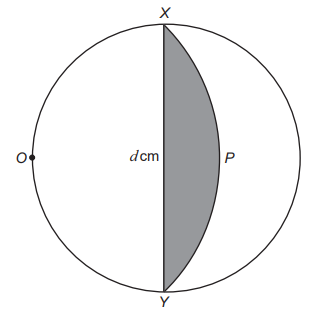
O is a point on the circumference of this circle such that a new circle with centre O passes through points X and Y.
P is a point on the new circle and the arc XPY is shown in the diagram.
Explanation
The correct answer is D.
OX and OY both represent the radius of the new circle whose arc is XPY. Let the radius of the new circle=t. Using Pythagoras’ theorem:
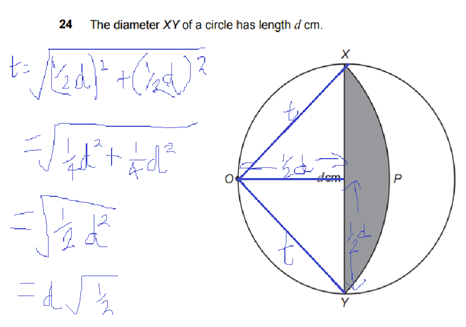
So the radius of the new circle is ![]() , so its diameter must be
, so its diameter must be ![]() .
.
We also know that angle XOY is 90 degrees, because the angle in a semicircle is always 90 degrees. So the arc must represent the 90/360=1/4 of the total perimeter of the new circle.
Knowing that the perimeter of a circle is calculated using pi x diameter, the perimeter of the arc of the new circle is ![]()
But the question wants the entire perimeter of the shaded region, so add on ![]()
Rationalizing the denominator, gives the answer D.
The diagram shows part of a DNA double helix being copied.
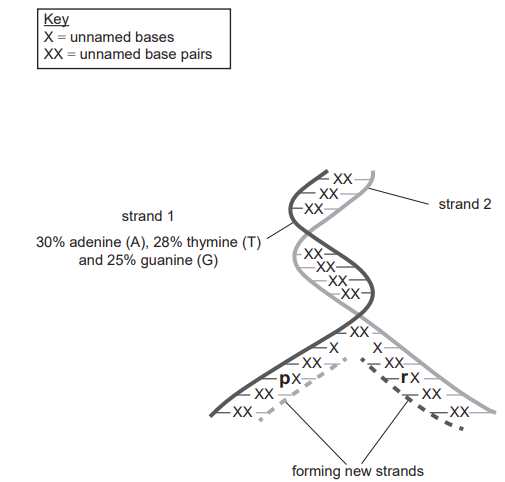
1- The probability of any base in strand 2 being guanine (G) is 0.17.
2- If p is guanine and r cytosine, a mutation must have taken place.
3- The copying process shown is taking place during mitosis.
Explanation
The correct answer is E.
Adenine pairs with thymine, and cytosine with guanine. Therefore all the cytosine bases on strand one will be paired with guanine on strand 2. So the percentage of C bases on strand 1 will be equal to the percentage of G bases on strand 2. The percentage of C bases on strand 1 is 100-(30+28+25)=100-83=17%. So 17% of the bases on strand 2 will be G, so statement 1 is correct.
If p was guanine, the x paired with the r on the opposite strand would have been cytosine when the two strands were joined, before these two strands were replicated. If the x was C, then r should have been G. But since r is taken as C, the adjacent base x must have been changed to G after the two strand were separated: a mutation has taken place. Therefore statement 2 is also correct.
DNA replication takes place before mitosis, so each of the two daughter cells produced have a full diploid set of chromosomes, so statement 3 is incorrect.
Therefore only statements 1 and 2 are correct.
Diammonium hydrogen phosphate, (NH₄)2HPO₄, can be used as a fertiliser.
The following equation shows how it can be synthesised:
2NH₃(g) + H₃PO₄(aq) → (NH₄)₂HPO₄(s)
Explanation
The correct answer is B.
There is no point converting kilograms to grams because the final answer is given in kilograms.
Number of kilomoles of ammonia= 3.4/17=0.2
From the reaction equation, ratio of moles of ammonia to moles of diammonium hydrogen phosphate= 2:1
Therefore theoretical number of kilomoles of diammonium hydrogen phosphate produced= 0.2/2=0.1
Theoretical mass of diammonium hydrogen phosphate produced= 0.1×131=13.2kg
Actual mass of diammonium hydrogen phosphate produced (given that the yield is 80%)= 13.2×0.8=10.56=10.6kg.
A bar magnet is rotating at a constant rate of 120 revolutions per minute inside a circular coil of wire, causing an induced voltage across the coil.
1- Increasing the number of turns of wire on the coil would increase both the maximum value and the frequency of the induced voltage.
2- The direction of the induced voltage in this coil reverses every 0.25 seconds.
3- There is always an induced current in a conductor which is experiencing a change in magnetic field.
Explanation
The correct answer is C.
Increasing the number of turns of wire on the coil would increase the maximum value of the induced voltage but not the frequency. So statement 1 is incorrect.
The bar magnet makes 120/60=2 revolutions per second inside the coil. The direction of the induced voltage changes twice per revolution, so the direction of the induced voltage would change 2×2=4 times per seconds, or every 0.25 seconds. So statement 2 is correct.
A current is induced in a conductor which is experiencing a change in magnetic field, as long as this is apart of a closed circuit. If the circuit is open, a current is not induced, so statement 3 is incorrect.
Therefore only statement 2 is correct.
BMAT 2020 S2 Review Screen
Instructions
Below is a summary of your answers. You can review your questions in three (3) different ways.
The buttons in the lower right-hand corner correspond to these choices:
1. Review all of your questions and answers.
2. Review questions that are incomplete.
3. Review questions that are flagged for review. (Click the 'flag' icon to change the flag for review status.)
You may also click on a question number to link directly to its location in the exam.
BMAT 2020 S2 Section
Final Answer Review Screen
Instructions
This review section allows you to view the answers you made and see whether they were correct or not. Each question accessed from this screen has an 'Explain Answer' button in the top left hand side. By clicking on this you will obtain an explanation as to the correct answer.
At the bottom of this screen you can choose to 'Review All' answers, 'Review Incorrect' answers or 'Review Flagged' answers. Alternatively you can go to specific questions by opening up any of the sub-tests below.
BMAT 2020 S2 Section
TI-108
Let's get acquainted ?
What is your name?
Nice to meet you, {{name}}!
What is your preferred e-mail address?
Nice to meet you, {{name}}!
What is your preferred phone number?
What is your preferred phone number?
Just to check, what are you interested in?
When should we call you?
What time works best for you? (UK Time)
How many hours of 1-1 tutoring are you looking for?
My WhatsApp number is...
For our safeguarding policy, please confirm...
For our safeguarding policy, please confirm...
Which online course are you interested in?
What is your query?
SubmitYou can apply for a bursary by clicking this link
https://www.medicmind.co.uk/medic-mind-foundation/Sure, what is your query?
SubmitLoading...
Thank you for your response.
We will aim to get back to you within 12-24 hours.
Lock in a 2 Hour 1-1 Tutoring Lesson Now
If you're ready and keen to get started click the button below to book your first 2 hour 1-1 tutoring lesson with us. Connect with a tutor from a university of your choice in minutes. (Use FAST5 to get 5% Off!)
Buy Now for £70